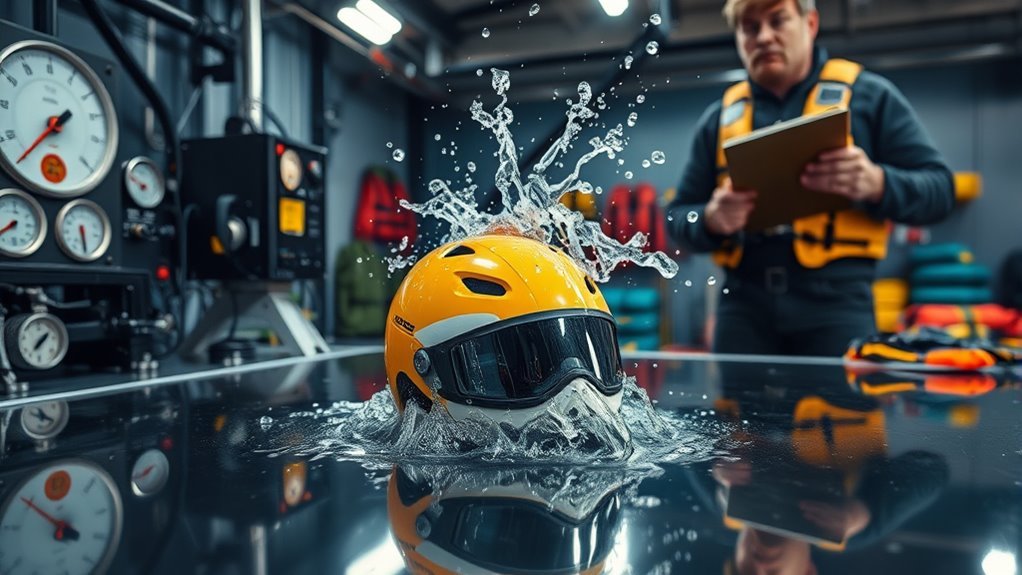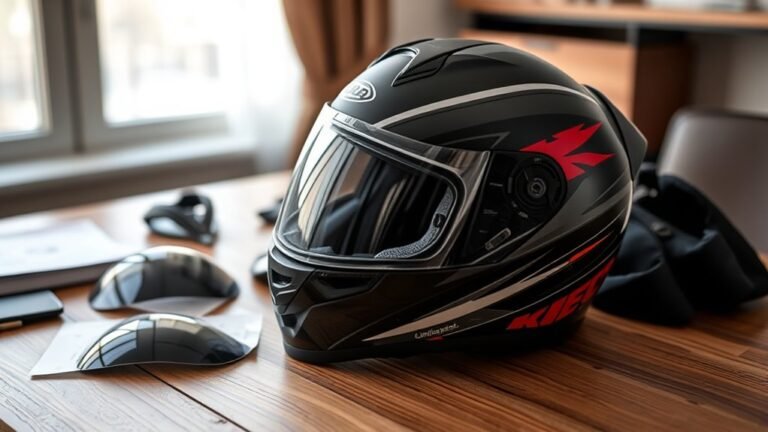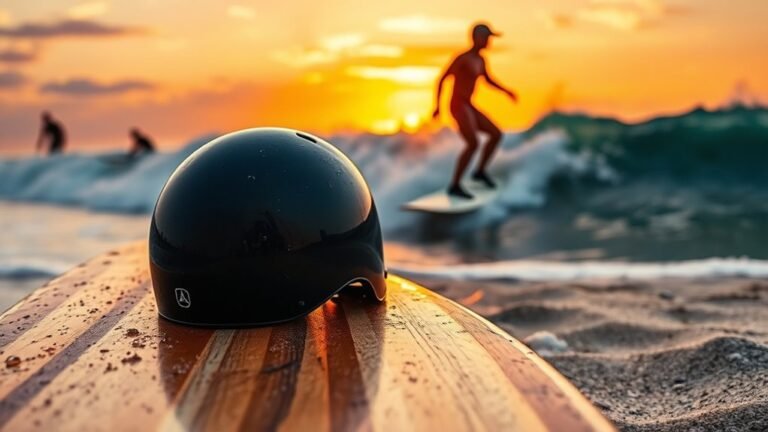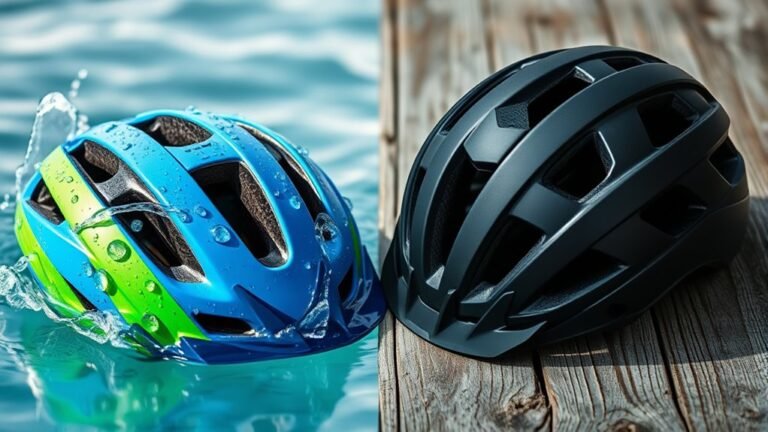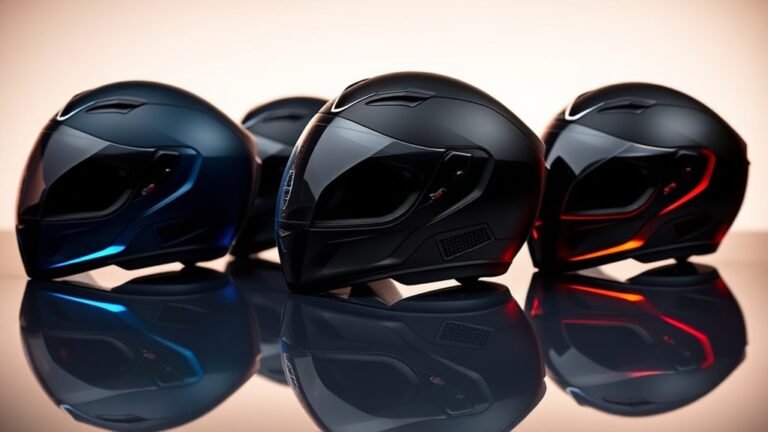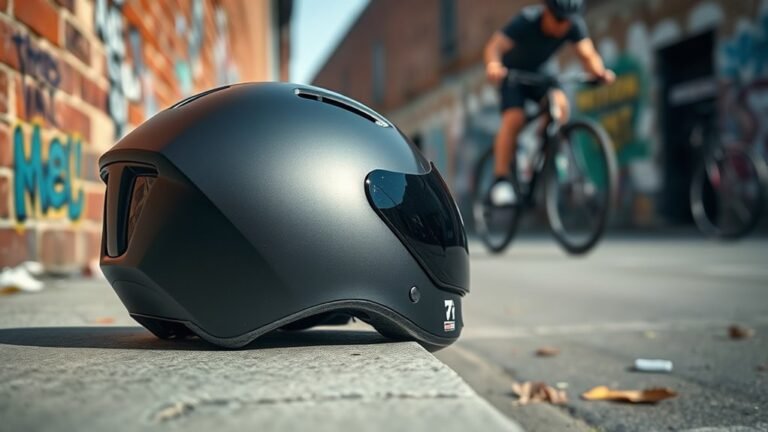How Water Sports Helmets Are Tested for Safety
Water sports helmets are rigorously tested for safety through various methods. These include drop tests that simulate real-world impacts, penetration resistance assessments for sharp object defense, and evaluations of retention systems to guarantee stability. Environmental resistance testing subjects helmets to extreme conditions, while real-world scenarios assess their performance during high-impact activities. Each test checks compliance with established safety standards. The continuous push for innovation assures your helmet stays reliable. You might find more intriguing details about these processes.
Importance of Water Sports Helmets
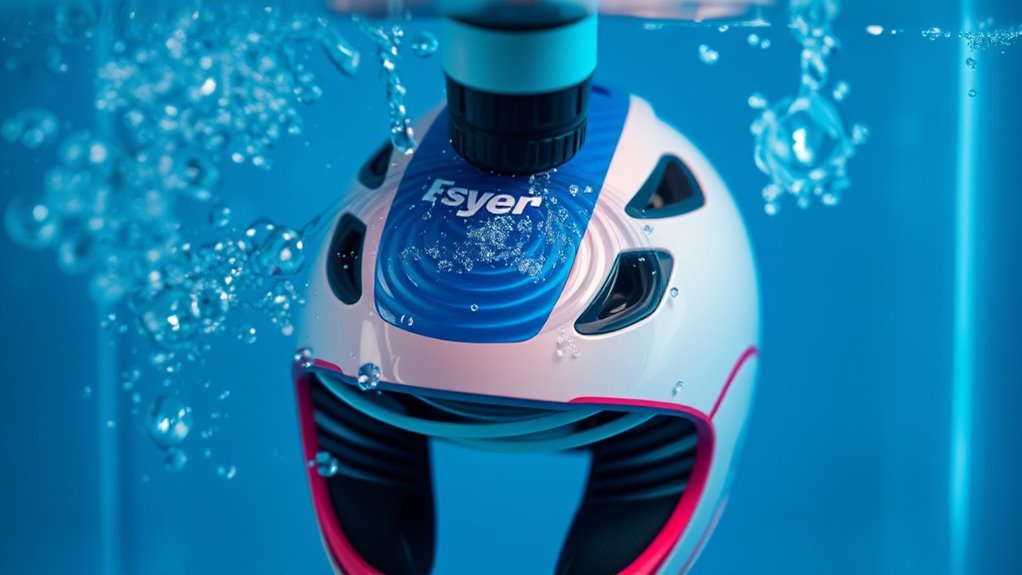
When you engage in water sports, the thrill of the activity can overshadow the potential dangers, which is why wearing a helmet is essential for your safety. Helmets offer significant helmet benefits, primarily focusing on injury prevention. They protect your head from impacts with obstacles or during falls, reducing the risk of concussions and other head injuries. The buoyancy of a helmet also helps keep your head above water, aiding in flotation during emergencies. Additionally, a well-fitted helmet enhances your visibility to others, contributing to overall safety on the water. By prioritizing helmet use, you’re not only embracing the freedom of your sport but also safeguarding yourself from unexpected hazards. Ultimately, it’s about enjoying your passion while minimizing risks.
Standards and Regulations for Safety
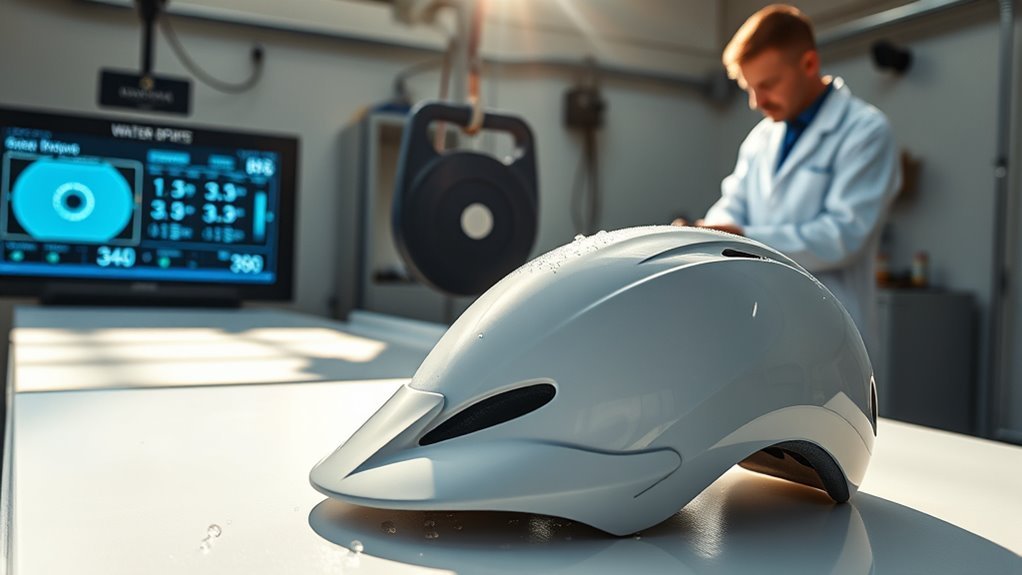
Understanding the importance of water sports helmets naturally leads to a discussion about the standards and regulations governing their safety. Various regulatory bodies establish guidelines to guarantee helmets meet stringent safety certifications. These standards not only protect you but also promote accountability among manufacturers.
| Regulatory Body | Safety Certification |
|---|---|
| ASTM International | ASTM F1447 |
| CE Marking | EN 1385 |
| Snell Memorial Foundation | Snell B-95 |
| ISO (International Organization for Standardization) | ISO 6220 |
Impact Testing Methods
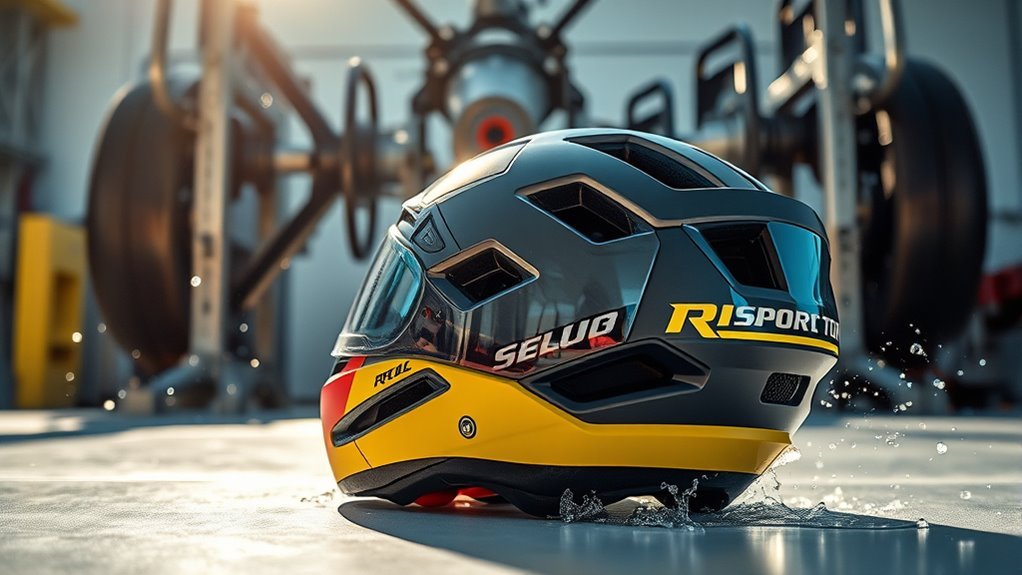
When evaluating the safety of water sports helmets, you’ll encounter various impact testing methods. Drop test procedures are critical for simulating real-world conditions, while impact absorption standards guarantee helmets can effectively reduce force during a collision. Understanding these processes is essential for judging helmet performance and safety.
Drop Test Procedures
Although testing procedures for water sports helmets may vary, drop tests serve as a fundamental method for evaluating their impact resistance and overall safety. In these tests, helmets are dropped from specific heights onto an anvil, simulating real-world impact forces. This method aligns with established testing protocols to guarantee reliability and consistency.
| Drop Height (cm) | Impact Force (N) |
|---|---|
| 100 | 150 |
| 150 | 200 |
| 200 | 250 |
| 250 | 300 |
| 300 | 350 |
Impact Absorption Standards
As manufacturers endeavor to enhance the safety of water sports helmets, impact absorption standards play an essential role in determining their effectiveness in real-world scenarios. These standards assess how well helmets can dissipate impact energy, a critical factor in minimizing head injuries. Here are four key methods used in testing impact absorption:
- Drop Tests: Helmets are dropped from specific heights onto various surfaces to simulate real-life impacts.
- Impact Testing Machines: Advanced equipment measures how helmet materials respond to sudden forces.
- Cushioning Evaluation: Testing examines the effectiveness of cushioning layers in absorbing shock.
- Material Analysis: Different helmet materials are evaluated for their ability to withstand and dissipate impact energy effectively.
These rigorous testing methods guarantee you’re protected while enjoying your freedom on the water.
Drop Tests and Their Significance
While you might think that a helmet’s primary function is to protect against impacts, the rigorous drop tests conducted during safety evaluations reveal how well these helmets can withstand real-world conditions. During these tests, helmets are dropped from specific heights to measure the impact force they can absorb without compromising safety. The results determine if a helmet meets the required safety standards. It’s essential to take into account helmet weight, as a heavier helmet can sometimes lead to increased impact force upon collision. However, the best designs balance lightweight materials with robust protective features, ensuring you have the freedom to enjoy water sports without sacrificing safety. Understanding these tests helps you make informed choices about the gear you wear.
Penetration Resistance Assessments
Penetration resistance assessments are essential in evaluating a helmet’s ability to protect against sharp objects that may be encountered during water sports activities. Effective penetration testing involves several steps to guarantee the helmet materials can withstand potential hazards. Here’s what’s typically assessed:
- Impact Simulation: Testing how the helmet reacts to sharp objects at varying speeds.
- Material Analysis: Evaluating the strength and durability of the helmet materials used.
- Depth Measurement: Measuring how far an object penetrates into the helmet.
- Safety Standards Compliance: Confirming the helmet meets established safety regulations.
These assessments help determine if a helmet can truly safeguard you, allowing for peace of mind and freedom while enjoying your water sports adventures.
Retention System Evaluations
To guarantee a helmet stays securely in place during water sports, retention system evaluations are essential. These tests assess the effectiveness of the retention system design, which includes straps, buckles, and adjustment mechanisms. You’ll find that the choice of retention system materials plays a significant role in performance; durable, lightweight materials enhance both comfort and security. Evaluators simulate various conditions, like sudden impacts or intense movements, to confirm the helmet remains snug. They also measure how easily you can adjust the system while wearing it, as quick adjustments can be critical for safety. By focusing on these factors, manufacturers can create helmets that not only provide freedom of movement but also safeguard your safety on the water.
Environmental Resistance Testing
When evaluating the safety of water sports helmets, it’s essential to assess their performance under various environmental conditions. You’ll want to understand how impact resistance standards are established and how water immersion durability affects the helmet’s integrity over time. By examining these factors, you can guarantee that the helmet will provide the necessary protection in real-world scenarios.
Impact Resistance Standards
Although you might not think about it while enjoying a thrilling day on the water, the safety of your water sports helmet hinges on rigorous impact resistance standards established through environmental resistance testing. These standards guarantee your helmet can withstand unexpected collisions, enhancing your freedom on the water. The process involves:
- Drop Tests – Helmets are dropped from specified heights to simulate impact scenarios.
- Force Measurement – The amount of force absorbed during impact is meticulously recorded.
- Material Analysis – The helmet’s materials are evaluated for durability and resilience.
- Safety Certifications – Helmets must meet industry standards to receive safety certifications, guaranteeing they provide adequate protection.
Water Immersion Durability
While you might focus on impact protection, understanding how water immersion durability is tested is equally important for guaranteeing a helmet’s long-term reliability. Water absorption tests expose helmets to prolonged immersion, measuring how much water the materials absorb. This is vital, as excessive absorption can compromise the helmet’s structural integrity. Following this, buoyancy assessments evaluate how well the helmet maintains its floatation properties. A reliable helmet should not become waterlogged, which can affect your maneuverability and safety in the water. These tests help manufacturers guarantee that helmets resist deterioration over time, allowing you to enjoy your adventures with confidence. By prioritizing water immersion durability, you’re investing in a helmet that stands up to the challenges of water sports.
Real-World Simulation Scenarios
As water sports enthusiasts know, helmets must withstand a variety of impacts and conditions that mimic real-life situations. To guarantee safety, manufacturers utilize realistic scenarios and advanced simulation techniques during testing. Here are some key scenarios they focus on:
- High-Impact Falls: Simulating sudden impacts from falls while wakeboarding or surfing.
- Collision Tests: evaluating how helmets perform when struck by objects like boards or other participants.
- Water Entry: Evaluating the helmet’s integrity when entering water at high speeds.
- Environmental Conditions: Testing for resilience against UV exposure and temperature fluctuations.
Continuous Improvement and Innovation in Helmet Design
Testing helmets in real-world simulation scenarios lays the groundwork for ongoing advancements in helmet design. You’ll find that design evolution is fueled by insights gained from these rigorous tests. Manufacturers analyze data on impact resistance, weight distribution, and ventilation to refine their products continuously. Safety advancements are paramount; each iteration aims to enhance protection without sacrificing comfort or mobility. You can appreciate how innovations like improved foam materials and streamlined shapes contribute to better performance on the water. As technology progresses, helmets become lighter and more effective, giving you the freedom to enjoy water sports with greater confidence. Embracing this cycle of improvement guarantees that you’re always equipped with the best protective gear available.
Frequently Asked Questions
How Often Should Water Sports Helmets Be Replaced?
You should replace your water sports helmet every three to five years, depending on usage and wear. Establish a replacement schedule to guarantee your safety. Helmets have a limited lifespan, as materials degrade over time, even if they look fine. If you’ve had a significant impact or noticed cracks, replace it immediately. Prioritizing a safe helmet means you can enjoy your water sports with peace of mind, embracing the freedom they offer.
What Materials Are Commonly Used in Helmet Construction?
When you think about helmet construction, you might be surprised by the materials used. Most helmets feature durable polycarbonate shells, designed to withstand impacts while remaining lightweight. Inside, you’ll find impact-resistant foams that absorb shock, providing essential protection during your adventurous escapades. These materials aren’t just about safety; they’re engineered for comfort too, allowing you the freedom to enjoy your water sports without compromising on security. Your head deserves the best!
Can Water Sports Helmets Be Customized for Individual Fit?
Yes, water sports helmets can be customized for an individual fit. Many models feature adjustable straps that allow you to fine-tune the fit for comfort and security. A custom fit is vital, as it guarantees the helmet stays in place during activities, providing ideal protection. When you’re out on the water, a snug yet comfortable helmet can enhance your freedom, allowing you to focus on enjoying your sport without distractions.
Are There Specific Helmets for Different Water Sports Activities?
Yes, there are specific helmets designed for different water sports activities. For instance, wakeboarding helmets typically feature a streamlined design and impact protection, ensuring you’re safe while performing tricks. On the other hand, kayaking safety helmets often have reinforced shells and additional padding to withstand potential collisions with rocks or other obstacles. Choosing the right helmet for your sport not only enhances your performance but also maximizes your freedom to enjoy the water more confidently.
How Do I Properly Care for My Water Sports Helmet?
To care for your water sports helmet, follow these helmet maintenance tips: After each use, rinse it with fresh water to remove salt and dirt. Use mild soap with a soft cloth for deeper cleaning, avoiding harsh chemicals. Inspect the straps and padding regularly for wear and tear. Store it in a cool, dry place, away from direct sunlight. These cleaning techniques guarantee your helmet remains durable and provides the safety you need.
